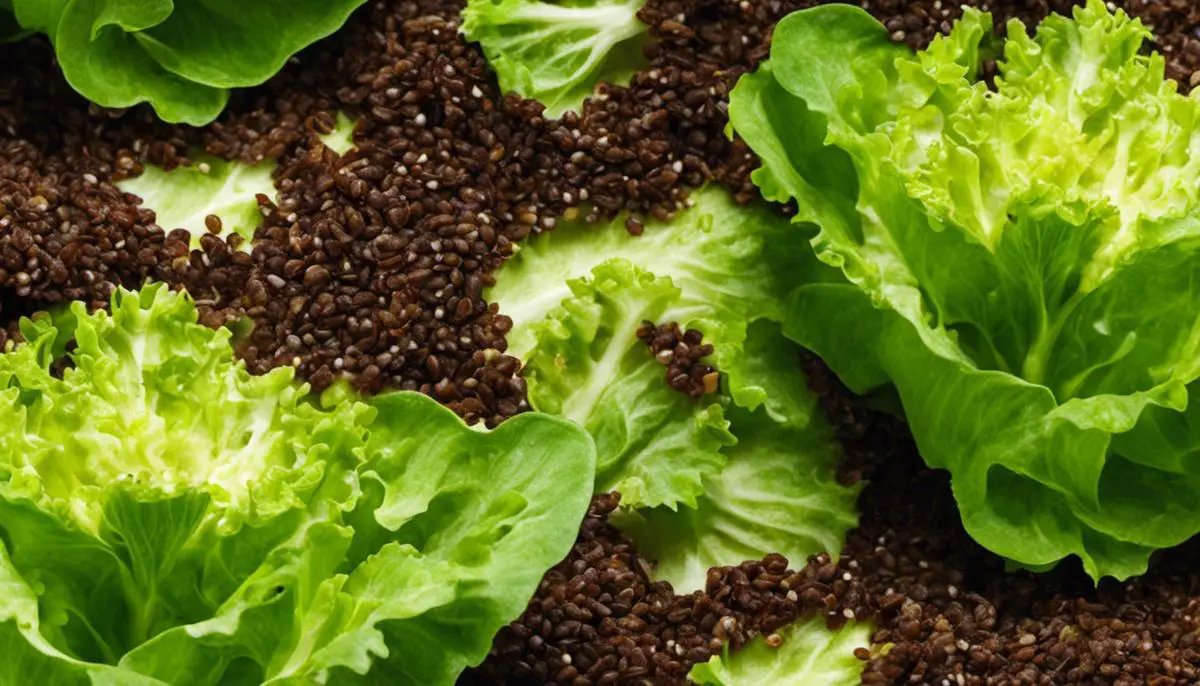There’s a unique satisfaction that comes from cultivating your own food sources, and starting plants from seeds can be an economical and rewarding process. Among the variety of greens that can be undertaken in home gardening, growing lettuce from seed consistently yields successful results, particularly when knowledgeable about the correct procedures. This informative resource provides a comprehensive guide to understanding the ideal conditions for lettuce seed germination, including temperature requirements, humidity levels, and light exposure. Additionally, it elaborates on the step-by-step process of starting lettuce seeds, elucidating on aspects like preparing your trays or containers, plant depth, watering methods, and monitoring the progress of the seedlings. Lastly, the guide delves into the transition process from seedlings to robust plants, enumerating on the ideal times and methods for transplanting without causing harm to the young plants.
Understanding Ideal Conditions for Lettuce Seed Germination
The Ultimate Guide to Germinating Lettuce Seeds
Hey, fellow garden enthusiasts! If lettuce plants are on your gardening radar this season, then buckle up – you’re in for a fantastic ride. Diving into the process of germinating lettuce seeds, while a fascinating journey, does require precise conditions. Understanding these conditions and harnessing your green thumb will lead to the freshest of homegrown salads. Is there a flavor more rewarding than that?
Reader Poll: What online courses would interest you?
First off, let’s talk about any gardener’s best friend – good soil. Loose, well-drained, and enriched in organic matter is the kind of soil lettuce seeds thrive in. A mix of compost, peat, and perlite should do the trick. Not forgetting the pH; aim for a score between 6.0 and 6.8 to offer the perfect playground for your seeds.
Temperature is the next big hero in the lettuce seeds’ germination story. These seeds are not sun-worshipping, warm-weather fans. No, they’re quite the opposite. For the best germination results, the soil temperature should be kept between 40 °F (4 °C) and 75 °F (24 °C). Beyond this range, the seed germination rates can drop dramatically.
It’s also essential to keep the light factor in check. Contrary to most seeds, lettuce seeds need light to germinate. Sprinkle your seeds on the soil surface, lightly covered with some peat moss, and make sure to position your planting tray in a well-lit area. If you’re sowing indoors, place the tray under grow lights for about 14 hours a day.
Subscribe to our newsletter!
Proper moisture management is critical to avert both drying out and waterlogging, either of which could spell doom for the germinating seeds. A handy secret is to use a spray bottle to keep the top layer of the soil adequately moist.
Patience is another key to lettuce seed germination. Although the seeds can germinate as quickly as 2 to 8 days in the ideal conditions, it’s crucial not to lose heart if it takes a bit longer. Gardening, after all, is not just about the outcome but also the process. It’s about nurturing and growing along with your plants.
In a nutshell, successful lettuce seed germination depends on the right synthesis of soil, temperature, light, moisture, and of course, your loving care. So, enthusiastic gardeners, it’s time to roll up your sleeves, dive into this adventurous process, and embrace the joy of watching your lettuce seeds begin their journey of growth. Get ready to reap the delicious rewards of this fulfilling endeavor!

Lettuce Seed Starting Process
“Let’s dive right into it, fellow green thumbs (and green thumb hopefuls)! We’re tackling a step that often perplexes beginners: starting lettuce seeds. With the excellent foundation you’ve already created by ensuring your soil, light, and moisture are primed and ready, you’re already halfway there!
We should steer our attention to the planting depth now, as the small size of lettuce seeds can stretch your precision. Make sure you don’t bury your seeds too deep; one-fourth to half an inch is an apt depth. Deeper, and your seeds may not have enough energy to push through the soil surface; you might even risk rotting in moist conditions.
Now, onto sowing guidelines. It might be tempting to jam-pack every bit of space in your seed tray to maximise your harvest. However, it is essential to give each lettuce seed plenty of its own room to grow and thrive. In seed trays, aim for spacing the seeds approximately 1 inch apart. This distance helps reduce competition for resources and decreases chances of disease spreading from seedling to seedling.
Next up, we mustn’t underestimate the importance of timing. If you’re sowing lettuce seeds outdoors, it’s all about timing your sowings for maximum results. Getting your timing right means you’ll reap fresh lettuce throughout the year. As a rule, cool-season crops like lettuce are best started in late winter for a spring harvest or in late summer for a fall harvest.
While outdoor planting is indeed an option, don’t underestimate the benefits of starting your lettuce seeds indoors. Transferring seedlings is a tad more work, yet it allows for more control over the growing conditions. You can bypass blistering winters or scorching summers by creating your own microclimate within your home. Once sprouted, they can get a gentle introduction to the outside world by being transferred to their outdoor location.
Remember to meet your lettuce seeds halfway by providing beneficial companions to grow with in the garden soil. Your lettuce will get on famously well with crops like radishes, carrots, or strawberries. Conversely, keep lettuce away from crops like broccoli or cauliflower, as these can inhibit their growth.
Last but certainly not least, don’t forget the element of excitement and joy. Seeing those first little green shoots bursting through the soil – there’s nothing quite like it. Experience the satisfaction of transforming minuscule seeds into bountiful, meal-ready lettuce, beaming with pride, as you serve your home-grown greens to family and friends.
Ready those trowels, folks – it’s time to plant!
You may now turn off your devices, get outside, enjoy the fresh air, and start your journey of growing your lettuce from seed. Remember, the only thing that grows faster than your plants is your passion for the process… In the vast garden of knowledge, we remain students. Keep nurturing those skills, cultivating curiosity, and, most importantly – Keep growing! Happy Gardening!”

Photo by markusspiske on Unsplash
Transplanting Lettuce Seedlings
Planting seedlings can be a thrilling part of the lettuce growing journey. Moving them successfully requires precise techniques, so here are some key strategies to put your seedlings on the right path for flourishing into crisp, refreshing heads of home-grown lettuce.
Firstly, it’s crucial to know when to transplant lettuce seedlings. Wait until they have two true leaves. These are the leaves that emerge after the seedling’s first two cotyledons, which are the embryo’s initial leaves. Waiting for the true leaves ensures that the seedling has enough of its own resources to handle the stress of transplantation.
Never forget the importance of hardening off seedlings before you transplant them, especially if they’re being moved outdoors. Starting two weeks prior to transplant, gradually expose the seedlings to outdoor conditions, increasing the time they spend afield each day. This acclimatization process will help them adjust to the potential shocks of temperature, wind, and full sunlight.
Use your hand or a trowel to dig holes in the transplant area. Make sure these holes are just deep enough to cover the roots of the seedlings. Natural hand tools work wonderfully for this task, creating small pockets that leave room for roots to spread.
Preserving the soil around roots during the transplanting process is elemental for the survival of lettuce seedlings. Using a spoon, gently scoop up the seedling from its original location, ensuring significant soil remains undisturbed around the roots.
Space out the seedlings properly in the new area. A good rule of thumb is to allow 8 to 12 inches between each one. This prevents competition for resources and gives each plant adequate room to flourish.
When secure in their new homes, consider giving the transplants a mild high-phosphorus fertilizer. This can boost root growth and help the seedlings to establish more quickly.
Watering is a final key step in the transplantation process. After the lettuce seedlings have been moved, run a gentle spray of water over them. This will settle the soil around the roots and provide the hydration needed for survival and growth. Continue to keep the soil evenly moist as the transplant evolves.
In conclusion, while transplantation may seem daunting, armed with these tips and a bit of diligence, those small seedlings can turn into abundant lettuce heads. Here’s to exploring the profound world of lettuce growth further, fostering a deeper bond with nature, and harvesting the fruits—or rather, crystals of the garden!

Though it comes with its set of challenges, starting lettuce seeds gives you the opportunity to learn something new and foster a sense of accomplishment as you watch your plants thrive. Understanding the intricate balance of temperature, humidity, and light needed for germination is crucial to this process. Equally important is getting your hands dirty while prepping your planting containers, setting your seeds at the perfect depth, and keeping an eye on the water needs of your growing seedlings. Furthermore, arming yourself with the right knowledge about when and how to transplant them ensures a healthy continuation in their lifecycle. With patience, attention and a little bit of practice, you’ll be well on your way towards harvesting your own home-grown lettuce, fresh from your garden straight to your plate.

